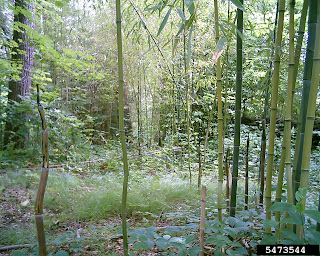 |
| Yellow groove bamboo, Phyllostachys aureosulcata invading a natural area image by Caryn Rickel, Institute of Invasive Bamboo Research, Bugwood.org |
The
sound and fury of invasive bamboo species run-a-muck and over-running property boundaries
has reached my county, Prince George's, just outside of Washington D. C. Gardeners
have long known the story that I often repeat in lectures and talks I give
across the county about the planting of so-called 'running bamboos' by
neighbors who plant these species for short term landscape problem
solving, ignorant of long term impact or just in plain spite. I use the story to
illustrate the problems and challenges produced by invasive species as they
move through and alter ecosystems and managed landscapes.
A
home owner and enthusiastic gardener spends twenty years landscaping his or her property
show casing the skills and artistry that comes with dedication and experience.
As with all gardeners, the homeowner loves to showcase the work and wonders of
the garden, but, alas, has a neighbor for whom the allure of gardening is nonexistent.
So the gardener shares with distant visitors the growing intricacies
of his or her work. Then one day the long time neighbor sells the next door house
and moves away. The gardener looks out the kitchen window, and sees, much to
his or her delight, that the new neighbor is coming around the corner with a
wheelbarrow filled with something green and tools for planting. The gardener is ecstatic, for now surely
there is someone with whom to share the stories and the surprises of the art and science of horticulture. Hurriedly the gardener puts together a tray of treats and a
pitcher of lemonade and sallies forth in eager anticipation of hours of shared
stories over the property line where the carefully tended 100 foot multi-species perennial
border flowers throughout the year. As the gardener
nears the property edge, the new neighbor is seen speedily digging holes along a line against the perennial garden; into each careful wrought hole inserting one sure-to-grow, fool-proof, lawn-mower resistant, and insect and
disease free bamboo plant from the genus Phyllostachys,
the great genus of running bamboos.
Imagine
now the new relationship, and consider the plight of the natural area land
manager who spends tent years protecting biodiversity only to have a manicured
subdivision plopped in next door to the wilderness area, with all the ornamental invasives ready to do the 'bamboo-thing', and you begin to understand the complexities
and complications of the bamboo wars writ large.
When
your bamboo comes onto my property why should I bear the cost to remove it?
Should not the cost of mitigation be on the originating property owner? Why should I have to deal with a species you
bought and you planted and that you allowed to roam, my land? If you had a pit bull running loose, I should
have recourse to have it controlled. Should not the same ideas be applied to
your aggressive plants? This is the root of the invasive species issue plaguing
neighbors who are dealing with bamboo incursions, loss of property use, and
destruction of infrastructure that comes from Phyllostachys spp. out of control.
see also:
see also:
SATURDAY, OCTOBER 13, 2012 Invasive Bamboo Wars Heat Up
Invasive Bamboo Plagues Mt. Rainier, Md.
http://www.wusa9.com/news/article/232369/158/Bamboo-Ban-Considered-In-Mt-Rainier-Md
6 comments:
Just today at our Master Gardener's holiday luncheon, a friend bemoaned her mother's yard.. due to invasive bamboo marching across from a neighbor.. Town has no laws & mom has no recourse..
Amok, no?
amuck (adv.)
17c., variant of amok; treated as a muck by Dryden, Byron, etc., and defended by Fowler, who considered amok didacticism.
from http://www.etymonline.com/index.php?term=amuck&allowed_in_frame=0
Need laws to stop the serious continual damages of invasive running bamboo - Phyllostachys spp. Giant timber bamboo -grows taller each successive year - very strong rhizomes which contaminate the land deep & far. This becomes a serious continual liability & also a damage to market value - "stigma" to any properties that the invasive running bamboo has or will invade. It picks up speed each year. Real Estate Appraisers are just starting to warn people. Buyers have backed out days before closing. Not easy to eradicate. Best to have laws before more land is contaminated. Most invasions in the Northeast are yellow groove- species Phyllostachys aureosulcata. Phyllostachys bissetii also widespread . The public needs to educate on this genus of invasive bamboo. Home inspectors need to learn how to identify Phyllostachys on a property before clearance. Laws are passing rapidly. Sellers will desperately try to diffuse what the scientific facts are regarding the data collected and verified. We know this will be a * major alien invader destroying assets and the natural ecosystem. The chemicals being used are very detrimental to human health and the environment. This is a quality of life issue. ( see Hempstead, New York ) unanimous vote. We are far along in the research now. The sellers , many who ship rhizomes on ebay, etc. , and sell online - craigslist etc. will continue to misinform the public. Call 203-734-6344 to find out what you can do to change this in your town or state.
website: https://sites.google.com/site/invasivebambooresearch/
Phyllostachys aurea is also very invasive. Most infestations in the Northeast are Yellow Groove, and most infestations in the Southeast are Golden Bamboo.
It's a problem in many Maryland counties. We need a law to make the planters responsible for the damage.
Post a Comment